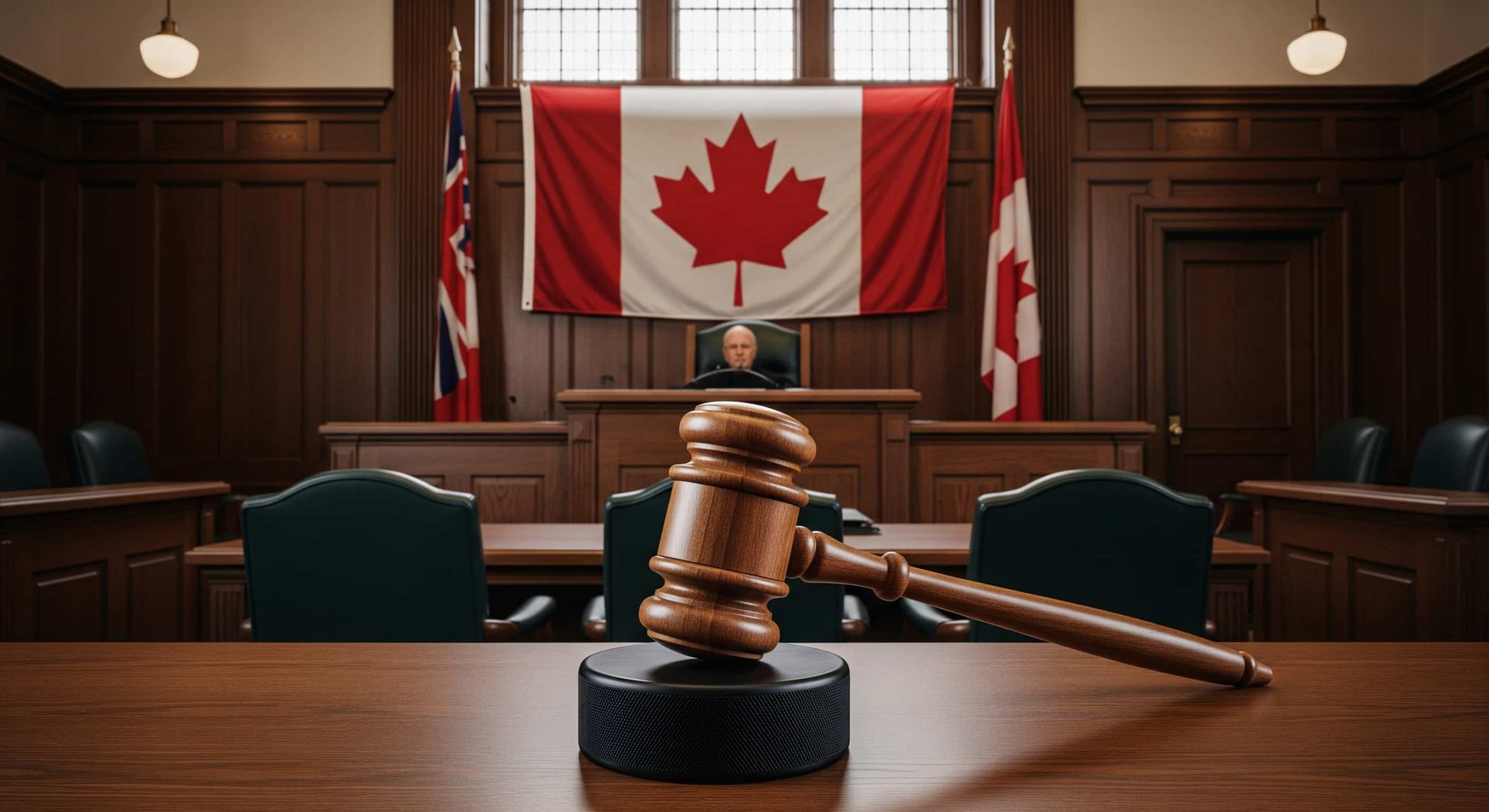- Our Firm
- Personal Injury
-
-
-
Personal Injury Lawyers
-
-
-
-
-
-
Injured in an accident? At Diamond & Diamond, our team of lawyers rely on their reputation in the field and extensive experience in personal injury to provide clients with a dedicated support system over the duration of their case.
-
-
-
-
-
HAVE YOU RECENTLY BEEN INJURED IN AN ACCIDENT?
-
-
-
- Corporate
- Class Action

Why Were the Hockey Canada Players Found 'Not Guilty'?
You may have heard the big news about a major court case involving five former members of Canada’s World Junior hockey team. After a long trial, the judge found them not guilty of sexual assault.
This news has been confusing and upsetting for a lot of people. You might be wondering: how could this happen? What does “not guilty” really mean? Let’s break it down in simple terms.
What Was the Case About?
Back in 2018, five hockey players were accused of sexually assaulting a young woman in a hotel room after a party. The players were Michael McLeod, Alex Formenton, Dillon Dubé, Carter Hart, and Cal Foote.
At first, the police looked into it but didn’t lay any charges. But a few years later, news came out that Hockey Canada had secretly paid the woman a sum of money to settle the issue. This caused a huge uproar. People were angry that player registration fees were used to pay for a secret settlement.
Because of the public anger, the police reopened the case. This time, the five players were officially charged with sexual assault. They all said they were not guilty, and the case went to a big trial.
On July 24, 2025, a judge made the final decision: all five men were found not guilty of all charges. The judge said she did not find the woman’s story to be “credible or reliable,” and that the lawyers arguing against the players (called the Crown) couldn’t prove the case.
The Most Important Thing to Understand: “Not Guilty” is Not the Same as “Innocent”
This is the trickiest part, but it’s the key to understanding the verdict. In our justice system, a “not guilty” verdict doesn’t mean a judge is saying, “I’m 100% sure nothing bad happened.”
It means the prosecution couldn’t prove their case beyond a reasonable doubt.
Think of it like this: Imagine a teacher accuses a student of cheating. To give that student a zero and fail them for the year, the teacher needs to be almost 100% certain. They need rock-solid proof. If the teacher is only 90% sure, they can’t fail the student. They have a “reasonable doubt.”
Does that mean the student is innocent? Not necessarily. It just means the teacher didn’t have enough proof to meet the very high standard required.
Our legal system has two different standards of proof for two different kinds of cases:
1. Criminal Court (Like this hockey trial)
- What is it for? To decide if someone committed a crime and should be punished (e.g., with jail time).
- How much proof is needed? A LOT. This is the “beyond a reasonable doubt” standard. It’s the highest level of proof in law. If the judge or jury has any reasonable doubt, they must find the person not guilty. In this case, the judge had doubts, so she had to find them not guilty.
2. Civil Court (Like a lawsuit for money)
- What is it for? To settle disagreements between people or companies, usually involving money.
- How much proof is needed? Much less. This is called the “balance of probabilities.” You just have to prove that it’s “more likely than not” (think 51% sure) that your side of the story is true.
This explains why Hockey Canada paid the woman a settlement long before the criminal trial ended. In a civil lawsuit, her lawyers would only have to convince a judge that it was more likely than not that she was assaulted. Facing that lower standard, Hockey Canada chose to settle.
As I mentioned in a recent video, it’s not unusual to see a not guilty verdict in a criminal case but a settlement in a civil case for the very same incident. The level of proof required is completely different.
What Happens Now?
Even though the players were found not guilty in court, this story is far from over.
- For Hockey: This case has forced Hockey Canada and the whole sport to look at its culture. People are demanding better education on consent and stronger rules for how to handle these kinds of accusations.
- For the Players: The NHL has said that even with the not-guilty verdict, these players are still not eligible to play in the league right now. Professional sports leagues can have their own rules of conduct that are separate from the law.
- For Survivors: For many people who have survived sexual assault, this verdict was heartbreaking. It can be discouraging and make people afraid to come forward. Protesters outside the courthouse wrote messages like “We believe you” to show support for the woman and other survivors.
Help Is Always Available
This case shows that the legal system can be complicated and the outcomes can be tough to accept. But it’s so important for anyone who has experienced sexual assault to know this: you are not alone, and a court verdict does not define your experience.
There are different paths to justice. A civil lawsuit, like the one that was settled in this case, is one of them. It allows survivors to seek compensation for the harm they’ve suffered, and it operates on that much lower “more likely than not” standard of proof.
If you have been assaulted, try to save any evidence you can (like text messages, photos, or clothing) and write down everything you remember as soon as you feel able. This can be very helpful later on.
Healing looks different for everyone. The most important thing is to know that what happened was not your fault and that there are people who want to help.
If you or someone you know needs to talk about your options, our team of sexual assault lawyers at Diamond & Diamond offers free consultations. We are here to listen and help you find the path to justice that is right for you.
Need a Lawyer?
We are here 24/7 to address your case. You can speak with a lawyer to request a consultation.
1-800-567-HURTGet started with a free consultation
OUR TEAM
- Ishmeet Sandhu
- Nolan Bachmann
- Marissa Faulkner
- Annamarie Demaj
- Jeffrey Hum
- Tofunmi Adeyeye
- Alessia De Gasperis
- Amandeep Chawla
- Jeremy Tsoi
- Kimiya Razin
- Bilal Hashimy
- Shir Zisckind
- Gray Sinden
- Shelly Bard
- Christian Brown
- Daly Canie
- Tanveer Sohal
- Prianka Virdi
- Noah Brownstone
- Justin Kaminker
- Harinder S. Bhatti
- Craig Yargeau
- Kiran Birk
- Amit Singh
- Andrei Teju
- Maria Zahid
- Matthew Douglas
- Jacob Elyk
- Harry Gill
- Kristina Olivo
- Egi Bano
- Cam Woolley
- Charles Thompson
- Alexandra McCallum
- John Sime
- Allan Cocunato
- Patrick Poupore
- Erika Henderson
- Marina Korshunova
- Brandon Handelman
- Regeena Alapat
- Ryna Kim
- Natalia Poliakova
- Isaac Zisckind
- Manpreet Bhogal
- Mathura Santhirasegaram
- Nikolai Singh
- Sandra Zisckind
- Jeremy Diamond
- Michael Blois
- Darryl Singer
- Nadia Condotta
- Tinashe Madzingo
- Megan Armstrong
- Veronica D’Angelo
- Corey J. Sax
- Scott Tottle
- Steven Wilder
- TJ Gogna
- Jillian Carrington
- Joshua Himel
- Simon Diamond
- Cory Rubin
- Simon Mariani
- Brandon Greenwood
- Basil Bansal
- Nastassia Ivanova
- Tania Fleming
- George Laloshi
- Patrycja Majchrowicz
- Diana Iakossavas
- Dior Africa
- Alex Ragozzino
- Liana Saccucci
- Richard J. Chang
Head Offices
Main Offices
Barrie
Main Office
168 Bayfield Street
Calgary
Main Office
1331 Macleod Trail SE, Suite 645
Edmonton
Head Office
4246 97 Street NW, Unit 103
Halifax
Consultation Office
1701 Hollis St
London
Main Office
256 Pall Mall St, Suite 102
Oshawa
Consultation Office
50 Richmond Street E, Unit # 108 B
Ottawa
Main Office
955 Green Valley Crescent, Unit 315
Sudbury
Main Office
31 Larch Street, Unit 300
Timmins
Main Office
120 Cedar Street South, Unit 002A
Toronto
Head Office
255 Consumers Road, 5th Floor
Vancouver
Head Office
1727 West Broadway, Suite 400
Windsor
Main Office
13158 Tecumseh Rd. E. Unit 3B
Additional Areas Served
Ontario
- Ajax
- Alberta
- Aurora
- Barrie
- Belleville
- Bowmanville
- Brampton
- Brantford
- Brockville
- Bracebridge
- Bradford
- Burlington
- Burnaby
- Calgary
- Chatham
- Cobourg
- Collingwood
- Cornwall
- Durham
- Edmonton
- Elliot Lake
- Etobicoke
- Georgetown
- Guelph
- Hamilton
- Huntsville
- Kanata
- Kelowna
- Kingston
- Kitchener
- Leamington
- London
- Markham
- Milton
- Mississauga
- Muskoka
- Niagara Falls
- Newcastle
- Newmarket
- North Bay
- North York
- Oakville
- Orangeville
- Orillia
- Oshawa
- Ottawa
- Owen Sound
- Parry Sound
- Perth
- Peterborough
- Pickering
- Prince Edward County
- Richmond
- Richmond Hill
- Sault Ste Marie
- Sarnia
- Scarborough
- St. Catharines
- St. Thomas
- Stouffville
- Sudbury
- Surrey
- Thunder Bay
- Timmins
- Toronto
- Uxbridge
- Vancouver
- Wallaceburg
- Waterloo
- Welland
- Whitby
- Windsor
- Woodstock













